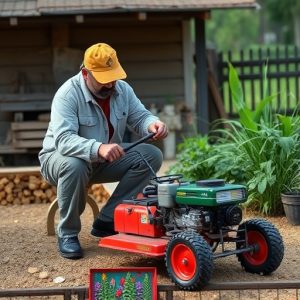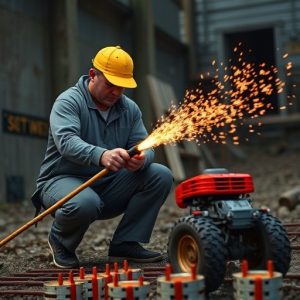Mastering Self-Defense with the Kubotan: A Comprehensive Guide on Its Use and Integration into Training Routines
The Kubotan is a specialized self-defense tool used in martial arts training to enhance hand strikes…….
The Kubotan is a specialized self-defense tool used in martial arts training to enhance hand strikes with increased force and precision. It's a short, thick stick that serves as an extension of the hand, enabling users to target specific areas on an attacker effectively. Proficiency with the Kubotan involves understanding its application in various scenarios, including striking techniques, controlling adversaries, and defending against multiple opponents. Training focuses on mastering stances, developing situational awareness, and integrating the tool into one's defense strategies. Achieving skill with the Kubotan requires consistent practice and guidance from experienced instructors. It's an essential part of Kenpo Karate and is used for both ranged and close-quarters combat. The efficacy of the Kubotan comes from its versatility, with techniques including strikes, holds, and pressure point applications. Learning how to use a Kubotan proficiently also involves developing instinctive responses for real-life self-defense situations, turning training into a practical tool for personal safety. Integrating Kubotan training into one's self-defense regimen can enhance martial arts skills and prepare individuals for a variety of defensive scenarios. Regular practice is key to mastering the Kubotan, with exercises focusing on target acquisition and incorporating its use alongside empty-hand methods for seamless defense responses. The goal is to develop muscle memory and confidence in using this tool effectively for self-defense.
discover the art of self-defense with a modern twist through Kubotan training, an empowering discipline that leverages a precise instrument for protection. This article delves into the essentials of wielding this self-defense tool effectively, offering insights into its purpose and applications. From grasping the Kubotan’s key components to mastering the techniques necessary for its use, readers will gain a comprehensive understanding of how to integrate Kubotan training into their self-defense routine. Dive into the world of Kubotan self-defense and learn how to use a kubotan with confidence and skill.
Mastering the Kubotan: Understanding Its Purpose and Application in Self-Defense
Mastering the Kubotan involves a deep understanding of its purpose and application within self-defense training. The Kubotan is a short, thick stick that can be used alone or with the hand as a weapon for self-defense. It serves as an extension of the hand and fingers, amplifying the force of strikes and providing a tool to control an attacker. Training in the use of a Kubotan requires learning how to handle it effectively, targeting vital areas of an assailant’s body with precision and control. Practitioners must familiarize themselves with the appropriate stances and techniques that enable them to wield the Kubotan in various self-defense scenarios. The effectiveness of this tool lies in its versatility; it can be used for striking, controlling, and even as a last resort for protection against multiple attackers. Understanding how to use a Kubotan is not just about knowing the mechanics; it’s about integrating the weapon into one’s self-defense skill set through consistent practice and situational awareness. Self-defense training with the Kubotan goes beyond mere familiarity; it involves developing instinctive responses and honing one’s ability to respond appropriately in potentially dangerous situations. This level of proficiency can be achieved through dedicated practice under the guidance of experienced instructors who specialize in Kubotan techniques and self-defense strategies.
The Anatomy of a Kubotan: Key Components and Techniques for Effective Use
The Kubotan is a short, thick stick of approximately half an inch in diameter and around six to ten inches in length, often made of wood, plastic, or metal. It serves as a versatile tool in self-defense training, particularly within the martial art of Kenpo Karate. To effectively use a Kubotan, one must understand its key components and techniques that enhance its application in various defensive scenarios. The primary components of the Kubotan include its length, which allows for both ranged and close-quarters engagement, and its texture, which can provide additional traction against an assailant’s grip.
Mastery of the Kubotan’s use involves a combination of strikes, control holds, and pressure point applications. Users should practice the techniques with precision to deliver controlled strikes that incapacitate without causing unnecessary harm. The Kubotan can be used to extend the reach of one’s arm, delivering powerful strikes from a distance that might otherwise not be possible. Additionally, it can be employed in conjunction with traditional hand techniques to control and neutralize an attacker. Proper training under the guidance of an experienced instructor is essential to safely and effectively wield the Kubotan. This includes understanding its leverage points, target areas on the body, and how to integrate it into a self-defense strategy that prioritizes situational awareness and personal safety.
Step-by-Step Guide to Integrating Kubotan Training into Your Self-Defense Routine
Incorporating Kubotan training into your self-defense routine can significantly enhance your martial arts skills and preparedness for real-world confrontations. The Kubotan is a short, thick stick that can be used as an extension of the hand in various striking techniques. To begin integrating this versatile tool into your practice, start with the basics: understand its length, weight, and grip. A proper grip is crucial for effectively channeling force through the Kubotan, which amplifies the impact of your strikes. Practice holding the Kubotan at the end closest to your knuckles, allowing your fingers to wrap comfortably around it.
Once you’ve mastered the grip, progress to learning basic stances and movements that complement Kubotan use. These stances will provide stability and balance during training, ensuring you can execute moves with precision and control. Next, familiarize yourself with the range of techniques, such as blocks, strikes, and disarms, that are specific to the Kubotan. Integrate these into your existing self-defense repertoire by practicing them in combination with empty-hand maneuvers. This will allow you to fluidly transition between using the Kubotan and defending yourself without it. Regular drills focusing on target acquisition, such as pressure points and vital areas, are essential for understanding how to use a Kubotan effectively. Remember to practice both offensive and defensive skills, as the Kubotan can be used not only to strike but also to control an assailant’s limbs or weapon. Through consistent practice and drilling, you will develop muscle memory and confidence in your ability to use the Kubotan as a complementary tool in self-defense situations.


